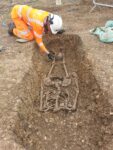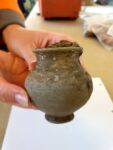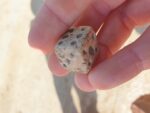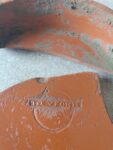 Archaeologists excavating the site of HS2 high speed rail construction in Fleet Marston, near Aylesbury, Buckinghamshire, have unearthed the remains of a small but busy Roman town and associated cemetery that contains 425 bodies, more than 40 of them decapitated.
Archaeologists excavating the site of HS2 high speed rail construction in Fleet Marston, near Aylesbury, Buckinghamshire, have unearthed the remains of a small but busy Roman town and associated cemetery that contains 425 bodies, more than 40 of them decapitated.
As was typical in the late Roman period, the cemetery predominantly contained inhumation burials but also included some cremation burials. The number of burials, along with the development of the settlement, suggests that there was a population influx into the town in the mid to late Roman period, linked perhaps to increased agricultural production. There are two separate areas of burials suggesting the cemetery may have been organised by tribe, family, ethnic grouping.
Amongst the buried population at Fleet Marston are a number of decapitated burials, approximately 10% of those buried there. There are several instances of the head being placed between the legs or next to the feet. One interpretation of this burial practice is that it could be the burial of criminals or a type of outcast, although decapitation is well-known elsewhere and appears to have been a normal, albeit marginal, burial rite during the late Roman period.
 Fleet Marston is a medieval town, but previous archaeological discoveries of pottery and coins indicated it had been preceeded by a Romano-British settlement. The town was traversed by a major Roman road linking Verulamium (modern-day St Albans) to Corinium Dobunnorum (modern-day Cirencester) and intersected at the town with several smaller roads. One of only two surviving intact Roman chicken eggs was found discarded in an ancient malting pit in nearby Berryfields.
Fleet Marston is a medieval town, but previous archaeological discoveries of pottery and coins indicated it had been preceeded by a Romano-British settlement. The town was traversed by a major Roman road linking Verulamium (modern-day St Albans) to Corinium Dobunnorum (modern-day Cirencester) and intersected at the town with several smaller roads. One of only two surviving intact Roman chicken eggs was found discarded in an ancient malting pit in nearby Berryfields.
 The crossroads location and density of pottery and coinage found suggested the Roman settlement may have been a market town and/or government administrative center. HS2’s archaeological program, therefore, dedicated more than a year to the excavation of Fleet Marston, unearthing as much of the ancient town as possible on both sides of Akeman Street, the Roman road that crossed it.
The crossroads location and density of pottery and coinage found suggested the Roman settlement may have been a market town and/or government administrative center. HS2’s archaeological program, therefore, dedicated more than a year to the excavation of Fleet Marston, unearthing as much of the ancient town as possible on both sides of Akeman Street, the Roman road that crossed it.
 They discovered the remains of domestic, commercial and industrial structures in a ladder pattern along the road, and remains of the limestone surface of the road itself and its drainage ditches.
They discovered the remains of domestic, commercial and industrial structures in a ladder pattern along the road, and remains of the limestone surface of the road itself and its drainage ditches.
The team has also discovered over 1,200 coins along with several lead weights, indicating that this was an area of trade and commerce. Parts of the widened road may have been used as a market, with extra room for carts and stalls. Other metal objects, such as spoons, pins and brooches, were of a more domestic nature, while gaming dice
and bells suggest that gambling and religious activity occupied people’s time here too. Apart from being home to many inhabitants, the settlement is likely to have been an important staging post for travellers and soldiers passing through Fleet Marston on their way to and from the garrison at Alchester.